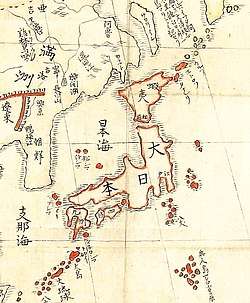Chōshō
Chōshō (長承) was a Japanese era name (年号,, nengō,, lit. "year name") after Tenshō and before Hōen. This period spanned the years from August 1132 through November 1135.[1] The reigning emperor was Sutoku-tennō (崇徳天皇).[2]
| History of Japan |
|---|
 |
Change of Era
- January 20, 1132 Chōshō gannen (長承元年): The new era name was created to mark an event or series of events. The previous era ended and the new one commenced in Tenshō 2, on the 11th day of the 8th month of 1132.[3]
Events of the Chōshō Era
- 1132 (Chōshō 1, 1st month): Fujiwara no Tadasane received a sign of the emperor's favor.[4]
- 1132 (Chōshō 1, 3rd month): The former-Emperor Toba decided to build himself a palace; and Taira-no Tadamori was placed in charge of its construction. When the project was completed, Tadamori was rewarded by being named governor of the island of Tsushima. Tadamori was a descendant of Emperor Kanmu.[4]
- 1132 (Chōshō 1, 3rd month): Emperor Sutoku made a pilgrimage to Mount Kōya.[4]
- August 1, 1133 (Chōshō 2, 29th day of the 6th month): Former-Emperor Toba had Fujiwara no Kanezane's daughter (the future Kaya-no In, 1095–1155) brought to his palace as his consort.[5]
- 1133 (Chōshō 3, 19th day of the 3rd month): Kanezane's daughter—Toba's consort—is advanced to the position of empress, but she bore no Imperial sons.[5]
- 1134 (Chōshō 3, 3rd month): The Emperor visited the Kasuga Shrine.[4]
- 1134 (Chōshō 3, 3rd month): Sutoku visited the Hiyoshi Taisha.[4]
- 1134 (Chōshō 3, 5th month): The Emperor visited the Iwashimizu Shrine.[4]
- 1134 (Chōshō 3, 5th month): Sutoku visited the Kamo Shrines.[4]
This era was known as a time of famine.[6]
Notes
- Nussbaum, Louis-Frédéric. (2005). "Chōshō" in Japan Encyclopedia, p. 123, p. 123, at Google Books; n.b., Louis-Frédéric is pseudonym of Louis-Frédéric Nussbaum, see Deutsche Nationalbibliothek Authority File.
- Titsingh, Isaac. (1834). Annales des emepereurs du japon, pp. 181-185; Brown, Delmer et al. (1979). Gukanshō, pp. 322-324; Varley, H. Paul. (1980). Jinnō Shōtōki, pp. 204-205.
- Brown, p. 323.
- Titsingh, p. 184.
- Brown, p. 93.
- Dobbins, James. (2004). Letters of the Nun Eshinni: Images of Pure Land Buddhism in Medieval Japan, p. 55.
gollark: Anyway, all the results so far have been loaded in.
gollark: We're using advanced three-dimension™ technology.
gollark: I'll put in 0x1 as "blood orange" from the xkcd color list because WHY NOT.
gollark: I suppose I could do that, but it might be inconvenient.
gollark: This is really proving surprisingly popular.
References
- Brown, Delmer M. and Ichirō Ishida, eds. (1979). Gukanshō: The Future and the Past. Berkeley: University of California Press. ISBN 978-0-520-03460-0; OCLC 251325323
- Nussbaum, Louis-Frédéric and Käthe Roth. (2005). Japan encyclopedia. Cambridge: Harvard University Press. ISBN 978-0-674-01753-5; OCLC 58053128
- Titsingh, Isaac. (1834). Nihon Ōdai Ichiran; ou, Annales des empereurs du Japon. Paris: Royal Asiatic Society, Oriental Translation Fund of Great Britain and Ireland. OCLC 5850691
- Varley, H. Paul. (1980). A Chronicle of Gods and Sovereigns: Jinnō Shōtōki of Kitabatake Chikafusa. New York: Columbia University Press. ISBN 9780231049405; OCLC 6042764
External links
- National Diet Library, "The Japanese Calendar" -- historical overview plus illustrative images from library's collection
| Preceded by Tenshō |
Era or nengō Chōshō 1132–1135 |
Succeeded by Hōen |
This article is issued from Wikipedia. The text is licensed under Creative Commons - Attribution - Sharealike. Additional terms may apply for the media files.